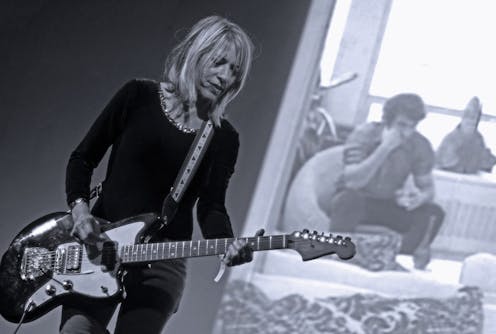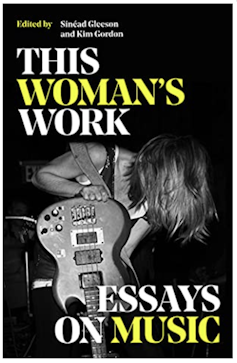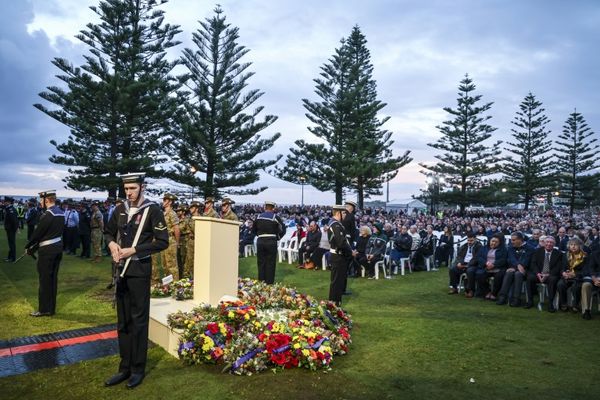
I wanted to start this piece with the Laurie Anderson quote, “Talking about music is like dancing about architecture”, but it turns out that Laurie never said it. And the adage has been through so many versions and origin stories that the harder I think on it, the more my head hurts.
Why can’t we write about music? Is it because we experience it in the body? Because we can’t see it to describe it? Is it just that we can’t write about music without writing about everything else?
In one of his last interviews, John Lennon, weary from years of scrutiny and over-interpretation, said
Listen, writing about music is like talking about f … ing. Who wants to talk about it? But you know, maybe some people do want to talk about it.
Historically, men have done most of the talking and writing about music. Publications of women’s music criticism exist but they are few and far between. In the last decade, more female voices have emerged, most notably in the area of memoir.
Read more: We crunched the numbers on ten recent ‘world’s best guitarist’ lists. Where are the women?
Often these are works of correction – Tracey Thorn’s My Rock’n’Roll Friend about Lindy Morrison’s pivotal role in the Go-Betweens comes to mind – but there is room for more. This Woman’s Work, a collection of essays by women about music, edited by Kim Gordon and Sinead Gleeson, is a sharp reminder of what we could have been reading all along.
The book takes its title from a Kate Bush song, which takes the perspective of a man whose wife is having a life-threatening labour. It describes a moment of realisation for him:
suddenly it’s the point where he has to grow up. He’d been such a wally up to this point.
This sentiment echoes where we are at in the world right now: the veil is down, the patriarchy is showing (wall-to-wall wallies). Even without the intel on Bush’s lyrics, the phrase “This Woman’s Work” feels fraught with associations of The Handmaid’s Tale, shitwork, invisible labour, sexism, misogyny and dismissal, but maybe I am just bitter from spending the 1990s in record shops hearing men talking to men about music.
Read more: My favourite album: Kate Bush's Hounds of Love

We all know and understand the feeling when a particular piece of music lands in us. We know the doors it can open, the emotion it elicits. Studies in neuroscience show the importance of music in shaping our identity, especially for teenagers.
Sociomusicologist Simon Frith argues popular music serves four functions: 1) to create self-definition and a place in society, 2) “to give shape and voice to emotions that otherwise cannot be expressed without embarrassment or incoherence” 3) to situate us in space and time, and 4) to round us out, fill a hole, provide posession/obsession that is connected to identity and taste.
While Frith is writing about popular music, the contributors in This Woman’s Work explore other genres too.
A mix-tape
Yiyun Li writes poignantly about the songs that fit into her life narrative, concluding that music (indeed all arts) become a “placeholder for life”.
Liz Pelly’s essay on Agnes “Sis” Cunningham – folksinger, communist, socialist, founder of Broadside music magazine – shows how music can function as a vehicle to political action.
For Ottessa Moshfegh, who grew up in the Boston classical music world, music was a pathway:
At some moments it overtook my life, at others I felt it ruined my life, and at others still, it was my salvation.
Fatima Bhutto, who was born and grew up in exile, draws connections between longing for homelands and music of resistance.
Tyrants hate music because no matter their force and their power, they will never, not ever, be able to control what is beautiful.
The essays in This Woman’s Work are transgressive, crossing categories and borders, time and space. The sum is constellatory – resembling a mix-tape jolting you from mood to mood.
From the surprising funny opener, in which Anne Enright describes meeting Laurie Anderson and being too star struck to speak coherently, to Sinead Gleeson’s careful comprehensive portrait of synth pioneer and perpetual outsider Wendy Carlos, to Margo Jefferson’s experimental evocation/adoration of Ella Fitzgerald, circling race, image, sweat and labour, the only constant is that each writer knows fully the world of her story.
As with any mix-tape, you will have your favourites. My research is about teenage identity construction in life writing and how objects and artefacts contribute to how we “make ourselves up”. Thus the standout essays for me are by Maggie Nelson and Leslie Jamieson. Both touch on the the fragility of the forming teenage self.
Nelson writes a lament for her friend, the singer Lhasa de Sela, who died aged 37 of breast cancer. In their teenage friendship Nelson often felt less “brilliant” (“more Lenu than Lila” she writes, referencing the protagonists in Elena Ferrante’s My Brilliant Friend), but even with its gaps and difficulties, their relationship helped guide Nelson towards who she would become.
Jamieson likewise shows tenderness for her teenage self. Analysing her collection of playlists from the last three decades she considers how she strove for male affirmation “by loving what they loved”. Then she remembers her first mix tape, made by her aunt (by marriage) featuring female musicians she’d come to love, such as the Indigo Girls and Dar Williams.
The essay ends with Jamieson, divorced, dancing with her daughter to Gloria’s cover of Talking Heads’ This Must be the Place in quarantine during the pandemic. It feels like a pilgrimage from becoming to unbecoming to just being.
I discovered just how liberating it can be to move beyond the words and live in the sound instead.
Each of the essays in This Woman’s Work invites the reader to do this. It feels like a gathering, one to which you could add your own song/story.
As a teenager I was always the one who would block anyone else from getting to the record player, but I’m older now, and humbled by how much I don’t know, and how much more there is to hear.
For the full experience of this book, there is a playlist on Spotify (of course!). And in a recent interview, Gleeson spoke about the possibility of this book begetting other books. Here’s hoping.
Simmone Howell does not work for, consult, own shares in or receive funding from any company or organisation that would benefit from this article, and has disclosed no relevant affiliations beyond their academic appointment.
This article was originally published on The Conversation. Read the original article.







